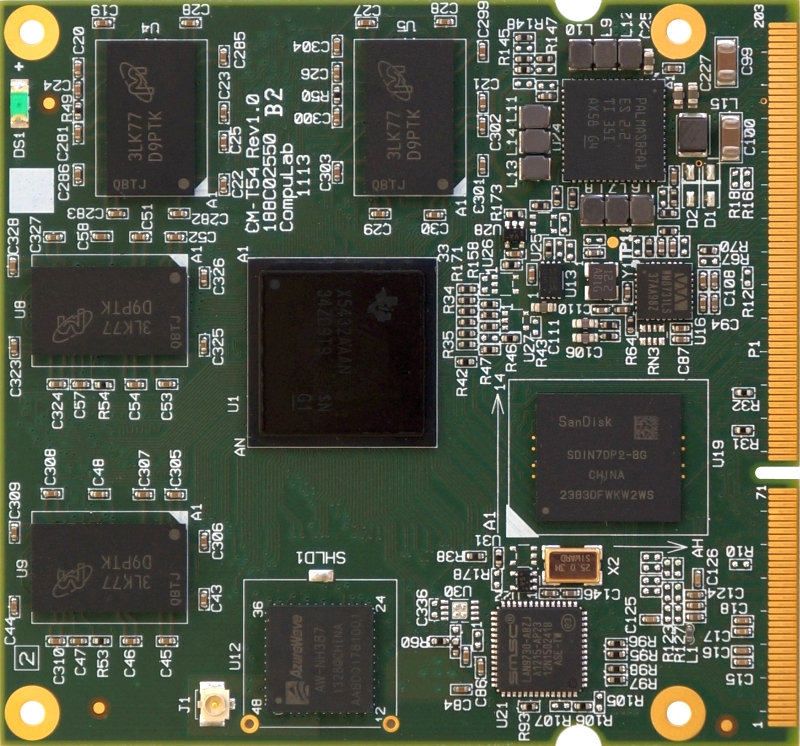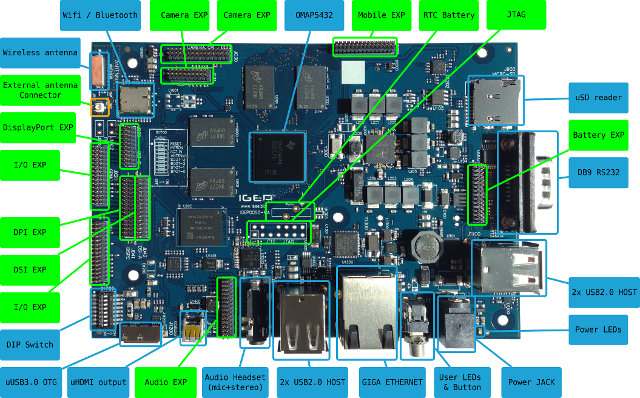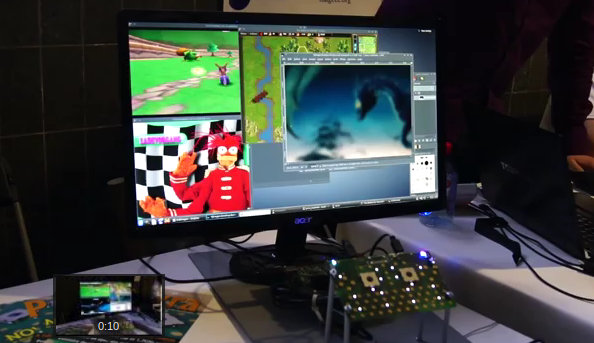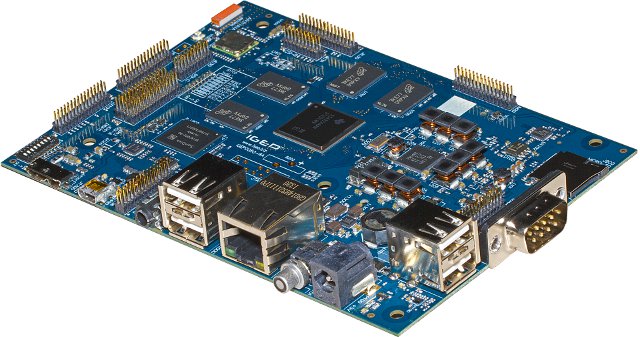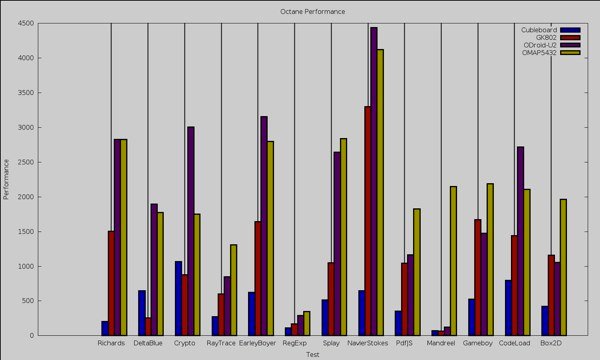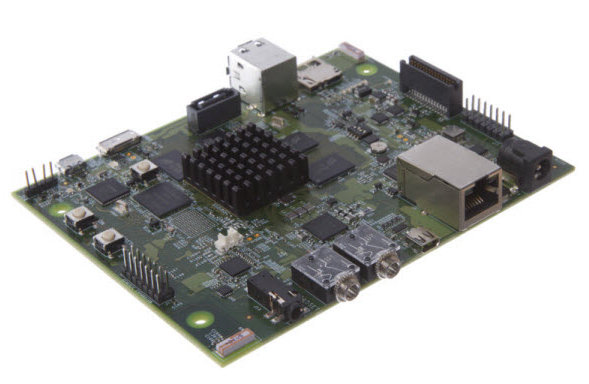CompuLab has introduced CM-T54 Computer-on-Module (CoM) powered by Texas Instruments OMAP5432 SoC with dual ARM Cortex-A15 CPU @ 1.5GHz coupled with Imagination Technologies PowerVR SGX544 GPU. The module also features up to up to 4GB DDR3, up-to 64GB eMMC, and provides Ethernet, SATA, USB 3.0 interfaces among others. Target applications include digital signage, industrial media players and IPTV. CM-T54 specifications: SoC – Texas Instruments OMAP5432 dual Cortex-A15 @ 1.5GHz with PowerVR SGX544 GPU, 2x Cortex M4 cores, IVA-HD video subsystem and TMS320DM64 32-bit DSP core System Memory – 512MB – 4GB DDR3-1066, single / dual-channel 32-bit data bus Storage – Up to 64GB eMMC flash, SATA II interface, 3.0 Gbps, Up to 3x MMC/SD/SDIO (3V levels) up to 32GB each. Display Parallel 24-bit display. Up to 1920×1080 @ 60Hz HDMI 1.4. Up to 1920×1080 @ 60Hz MIPI/DSI (4x lanes) @ 1Gbps Optional LVDS. Up to 1920×1080 @ 60Hz Support for […]
IGEPv5 OMAP5432 Development Board is Now Available for 149 Euros
ISEE IGEPv5 development board announced in October 2013, and powered by Texas Instrument OMAP5432 dual core Cortex A15 + dual core Cortex M4 SoC, POWERVR SGX544MP2 and Vivante GC320 GPUs is now available for as low as 149 Euros. There are two versions: “IGEPv5 OMAP5432 Communication Edition” for hobbyists with limited support, and “IGEPv5 OMAP5432” directly supported by ISEE. There’s also “IGEPv5 Custom Design” if you have specific requirements for your product. Hardware specifications are shared by both versions but with significant differences (CE = IGEPv5 OMAP5432 Community Edition, ISEE = IGEPv5 OMAP5432): SoC – Texas Instruments OMAP5432 dual core Cortex A15 up to 1.5 GHz (CE) or 2 GHz (ISEE), dual core Cortex M4, with POWERVR SGX544 dual-core GPU, Vivante GC320 GPU, and TMS320DMC64x DSP System Memory CE – 1GB DDR3 @ 1066 MHz ISEE – Up to 4 GB DDR3 RAM expandable to 4GB Storage CE – No eMMC, […]
DragonBox Pyra Open Source Handheld Game Console To Feature TI OMAP5432 SoC.. or AllWinner A80, or Intel Bay Trail, or Qualcomm Snapdragon…
Pandora is an open source handheld console which development started as far back as 2007. The project has had ups and downs, and some people have yet to receive the device they pre-ordered. As many components are now more difficult to source, Pandora has reach end-of-life, as Pandora 2 is now being developed with a subset of the original team, but has been renamed to DragonBox Pyra to start afresh. The new version aims to take to the good aspects of the original Pandora, and improve on the bad ones, so that DragonBox will have a faster hardware with a better looking case and better control. Here are the specifications listed on the project website: SoC – Texas Instruments OMAP 5432 SoC with 2x ARM Cortex-A15 @ 1.7Ghz with NEON SIMD, 2x ARM Cortex-M4, Imagination Technologies PowerVR SGX544-MP2 GPU for 3D graphic, and Vivante GC320 GPU for 2D graphics System […]
ISEE Introduces IGEPv5 Board Powered by TI OMAP5432 Processor
ISEE made a call to developers late 2012, asking them what features they’d like for an OMAP5 board. IGEPv5 board is now nearly completed, and people can register their interest to receive the development board in January 2014. IGEPv5 Specifications: SoC – Texas Instruments OMAP5432 dual core Cortex A15 up to 2GHz with POWERVR SGX544 dual-core GPU, and TMS320DMC64x DSP System Memory – 2GB DDR3 RAM expandable to 4GB Storage – Up to 32GB eMMC i-NAND, microSD socket, and mSATA2.0 Interface Connectivity: Ethernet controller: 1 x 10/100/1000Mbps Gigabit Ethernet PHY controler (RJ45) Wifi: 802.11 b/g/n Bluetooth v4.0 Antenna: Internal Wifi/BT Antenna USB – 1 x USB 3.0 OTG (miniAB receptable), 4 x USB 2.0 Host (Type A receptable) Video – 1 x microHDMI (Video + Audio) Audio – 1 x Stereo Audio In (Stereo minijack), 1 x Stereo Audio Out (Stereo minijack) Debugging – DEBUG SERIAL CONSOLE via RS232 (DB9), […]
Texas Instruments OMAP5432 EVM Benchmarked Against ODROID-U2, BeagleBone Black, GK802… and an Intel Core i7-2600K based PC
Texas instruments and SVTronics announced an OMAP5 evaluation board a couple of months ago. The board features OMAP5432 dual Cortex A15, dual Cortex M4 SoC, 2GB RAM, a 4GB eMMC module, USB 3.0, SATA and more. SVTronics sent a board to Linux.com, where they wrote a short review, followed by an article benchmarking the OMAP5 EVM against AllWinner A10, Freescale i.MX6, Exynos 4412 Prime, and TI Sitara platforms, namely Cubieboard, GK802, ODROID-U2, and BeagleBone Black, all running Linux. Ben Martin, the writer, also benchmarked the board against a Linux PC powered by an Intel Core i7-2600K processor (4 cores, 8 thread, clocked at 3.4GHz, with a turbo frequency up to 3.8GHz). The board used was an early version, clocked at 800MHz, and later in September, all boards will be clocked at 1.5Ghz, so for benchmarks that stress the CPU, you could expect almost double the performance. With that in mind, […]
$329 Texas Instruments OMAP5432 EVM / Development Board
Earlier this month, Texas Instruments has apparently discreetly, not to say surreptitiously, launched their OMAP5432 evaluation module. Beside the dual Cortex A15, dual Cortex M4 OMAP5 SoC, the board comes with 2GB RAM, a 4GB eMMC module, USB 3.0, SATA and more. OMAP5432 EVM Specifications: SoC – Texas Instruments OMAP5432 Multicore ARM Cortex A15/M4 processor with PowerVR SGX544MP2 GPU System Memory – 2GB DDR3L (implemented using 4x Micron 4Gb DDR3L devices (MT41K256M16HA-125:E) Storage – 4GB EMMC/iNAND Ultra device + SD/MMC 4-bit Micro-SD card cage Display / Video: HDMI via native OMAP HDMI interface DSI Display Expansion (DSIPORTA and DSIPORTC) via 100-pin expansion connector Parallel Display Expansion (DPI) via 100-pin expansion connector Audio – Audio Jack 3.5mm, Stereo out & in, Headset Jack (earphone/microphone) USB – 3x USB HS 2.0 (2 via USB connector, one via 0.1″ header), 1x USB 3.0, and 1x USB OTG 2.0/3.0 Connectivity – 10/100 802.3u Ethernet. […]
Open ARM GPU Drivers FOSDEM 2013 Video and Call to ARM Management
As I previously wrote, FOSDEM organizers are slowly uploading FOSDEM 2013 videos. One of the most interesting talk “Open ARM GPU Drivers” is now available. I’ve also uploaded it to YouTube (embedded below) to give it more exposure. Luc Verhaegen has also written a recent blog post entitled “Hey ARM!” where he announces the release of the modified source for Quake 3 Arena demo, and asks ARM to join them in making an open source driver. Open ARM GPU Drivers @ FOSDEM2013 This session covers the following key points: Problem – Binary drivers are mainly designed to run in Android, and it’s very difficult to have proper GPU drivers for Linux, and companies are not interested to release open source drivers or even just documentation, as they are not convinced it will benefit them in any way. Legal – This is actually the main issue, as open sourcing existing driver […]
Linaro 13.01 Release with Linux Kernel 3.8 and Android 4.2.1
Linaro has just announced release 13.01 which includes Linux Kernel 3.8-rc4 and Android 4.2.1. A lot of work seems to have gone in Arndale board and OpenEmbedded ARMv8. It’s the first time an Ubuntu image is released for Arndale Cortex A15 development board. One the kernel side some Android upstreaming work has been done, as well as some fixes for eMMC, and code for ST Ericsson Novathor 8500 SoC has been reorganized. Version 14 of the big.LITTLE MP (Multi Processing) has been released. The LEG has done further work on Linaro UEFI and GRUB. Here are the highlights of this release: Android Platform Work The first step of the android-build front-end update for new build program has been landed. Origen and Versatile Express manifests have been consolidated into a single manifest. linaro-android-tools were developed to improve development time for kernel developers. See Kernel Update Tools for details. The android-build scripts […]


